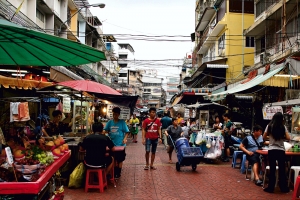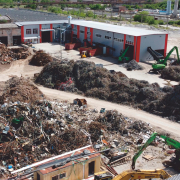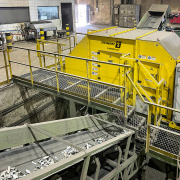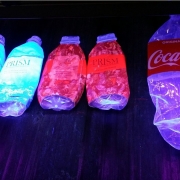Better Waste Management to Combat Climate Change
In March this year, the Thai Public Broadcasting Service reported that Thailand’s Ministry of Natural Resources and Environment would propose to the cabinet a total ban on the import of plastic waste into the country.
According to the information, the imports of plastic waste are to end at the beginning of 2020. At the same time, the country “will increase recycling of locally-generated plastic waste by as much as 100 percent within ten years, with the application of new measures that will require plastic products to contain a certain percentage of recycled plastic.” Natural Resources and Environment Minister Gen Surasak Karnjanarat was quoted that he is confident that Thailand has the technology and facilities to reach this goal.
As further reported by the Thai Public Broadcasting Service, in the Kingdom of Thailand about two million tons of plastic waste are generated each year, but only 500,000 tons are recycled. The currently imported volume of plastic waste is being used for the production of plastic products to save cost.
Managing municipal solid waste
The “Thailand State of Pollution Report 2017”, published by the Pollution Control Department of the Ministry of Natural Resources and Environment, pointed out that in that year the amount of municipal solid waste had not decreased compared to prior years. In 2017, about 67 million Thai people generated approximately 27 million tons of municipal solid waste. The volume had increased by 1.15 percent due to the population growth, city expansion, urbanization, consumption behavior and tourism.
According to the Pollution Control Department, the country’s waste management had a good trend. After being segregated at source approximately 8.51 million tons of waste (or 31 percent) was utilized, representing an increase of 47 percent compared with the previous year – the lion’s share was recycled waste (84 percent); the amount of utilized organic waste reached about 15 percent. The remaining waste of 11.69 million tons (43 percent) was collected and went for proper disposal, an increase of 22 percent over the previous year. 7.17 million tons (or 26 percent) of the waste was improperly disposed of (by open dumps, open burning or illegal dumping in public areas or water sources). As stated, this disposal method had decreased by 39 percent in 2017.
The improvements in waste management resulted from the government’s policy after having put the waste management on the national agenda of 2014, the authors of the report underlined. Furthermore, the campaign of raising awareness of the people about waste reduction by sorting the waste at the source had supported the positive trend of waste management.
In the year under review, there were 3,101 municipal solid waste disposal sites countrywide. Out of this number, 2,867 disposal sites were in operation (234 sites were already closed particularly the small solid waste disposal sites in villages, or community and the waste storage areas which were almost full). The operating sites had 2,914 waste disposal systems. Out of this number, 677 disposal systems – such as mechanical-biological treatment, incinerators with air pollution control, segregation, compost and correct landfill systems – were properly implemented, “while 2,237 disposal systems were not implemented correctly and needed to be improved to minimize the environmental impact,” the report stated. “Such impact would cause trouble to people living around the waste disposal sites, which might lead to the opposition to the disposal sites construction in the future.”
The re-utilization of waste to be used as fuel for electricity generation according to the government policy and the goal of the Ministry of Energy has also supported the waste management of the local administration organization, the reader could learn. At that time, there were 32 waste power plants of the generating capacity of 190.491 MW (megawatts). “In order to promote private participation in waste management, the extension of time for the support of purchasing electricity from waste power plants (Feed-in Tariff: FiT) which will come to deadline in September 2019, should be considered,” the Thai Pollution Control Department proposed.
Other wastes
In 2017, out of the estimated 618,700 tons of municipal hazardous waste, the biggest amount came from electrical and electronic equipment (WEEE), accounting for 401,300 tons or 65 percent. The rest of about 216,600 tons (or 35 percent) was household hazardous waste – such as batteries, dry cell batteries, chemical containers and spray bottles – which were thrown away with general solid waste.
“In managing the municipal hazardous waste system, the local administration organizations and related agencies set up a receiving point for hazardous waste in the village or community to be collected and transported to the provincial hazardous waste storage centers which comprise presently 80 centers,” the “Thailand State of Pollution Report 2017” said. As a result, the proper management of municipal hazardous waste had increased by 10 percent (or 60,600 tons). However, this was not considered adequate. “The issuance of regulatory guidelines for segregation municipal hazardous waste from general solid waste and the enforcement of a law requiring responsibility of the private sector for the management of waste from electrical and electronic equipment should be accelerated,” the Pollution Control Department urged. On the subject of industrial waste, out of the total amount of 32.95 million tons in 2017, which has been under an appropriate management system, 31 million tons was non-hazardous and 1.95 million tons hazardous waste. Approximately 20.8 million tons of this waste type had been utilized by burning for energy, making compost, sorting for selling, and sea reclamation or landfilling. As underlined, there are treatment and disposal facilities in each region of the country. “However, the problem of illegal dumping of hazardous industrial waste in old pits, unseen places along the roadsides or in the landfills of general waste needs more monitoring.”
To improve the country’s waste management in the future, the Pollution Control Department suggested:
■ Setting up rules/regulations or requirements by designing products and packaging to be environmentally friendly (eco-design) to reduce the amount of waste.
■ Reducing the amount of waste by sustainable management such as waste utilization, waste to energy, making organic fertilizer etc.
■ Reducing the production and consumption of products, which are made from non-biodegradable plastic and single-use product.
■ Setting up the permit system for disposal areas of municipal solid waste, hazardous waste and infectious waste to be implemented by private and public sectors.
■ Ending the improper waste disposal sites by having no open dump within five years by local administration organizations.
■ Allowing a charging fee for packaging for products, which are difficult to eliminate and accelerating the law enforcement to expand the role and responsibility of private sector (producer) in managing hazardous waste of electrical and electronic equipment.
■ Cancellation of the use of agrochemicals prohibited by the international Convention or which there is scientific evidence of their harm to people’s health.
■ Developing the role and responsibility of the private sector in managing the chemical residues or deteriorating chemicals as well as the product waste.
In 2019 alone, the country intends to eliminate 7.7 million tons of waste, according to the National Solid Waste and Hazardous Waste Management Master Plan (2016-2021). As Thais could read in the newspaper “The Nation” in December last year, the Pollution Control Department has issued four guidelines for local administrative bodies and related agencies “to effectively manage garbage and waste” – and also to minimize the negative impacts on people’s health:
■ A guideline for the selection of appropriate technology for garbage and waste management.
■ A guideline focusing on the incineration/combustion method, which will be divided into four groups.
■ A guideline on underlying characteristics for refuse-derived fuel (RDF) made from waste in communities, which details the physical attributions (such as net calorific value, moisture, and bulk density) and the chemical attributions (such as chlorine amount, ash, and mercury/cadmium/heavy metal amounts) as well as methods for sample collecting, analysis and testing and transporting.
■ A guideline on basic design and construction of waste separating and processing for the RDF production and measures to prevent and reduce negative impacts on the environment.
Business opportunities
The goal of the Thai government to reduce the country’s waste volume creates also business chances with regard to recycling. As reported by the newspaper “Bangkok Post” in October last year, there is a demand for waste-to-energy plants. The national power development plan for 2014-2036 has set a goal to achieve 550 MW (megawatts) from waste-to-energy power projects by 2036. According to the information, at that time 33 waste-to-energy projects were in operation with a combined capacity of 203 MW, while 55 projects were in the development phase. However, Thailand has – in the opinion of sector representatives – potential in more waste-to-energy power projects, the newspaper wrote.
The Bangkok-based international law firm Pugnatotius Ltd. – a provider of transactional legal and tax advice on foreign investments in Thailand’s manufacturing and service industries as well as property developments and acquisitions – is convinced that there are opportunities in Thailand’s recycling sector. The areas mentioned include – in addition to waste-to-power plants – waste management, waste-reusing schemes, waste-reducing strategies, plastic waste, e-waste and hazardous waste.
For investors who wish to set up an operation in Thailand, the best contact point is the Office of the Board of Investment (BOI), which operates under the Prime Minister’s Office and is the principal government agency for encouraging investment. On its homepage, one can find announcements like the “Promotion of Smart City Development” (www.boi.go.th/index.php?page=boi_announcements), guides like the information about special measures for investment stimulation in the Thailand Investment Year 2019 (www.boi.go.th/un/guides) and hints how to do business with BOI (www.boi.go.th/index.php?page=doing_biz_boi).
The Asian Development Bank (www.adb.org) publishes project data sheets, documents and tenders from many Asian countries, including Thailand.
________________
Waste management and climate change
The Kingdom of Thailand has committed to climate-change prevention and intends to reduce greenhouse gas emissions economy-wide by 20 percent from the projected business-as-usual (BAU) level by 2030, the World Bank stated 2017 in an account related to policy analysis activities. The country’s baseline emission in 2030 is projected to be 555 MtCO2 (million tons equivalent CO2) in the BAU scenario.
According to the information, the “level of contribution could increase up to 25 percent, subject to adequate and enhanced access to technology development and transfer, financial resources and capacity building support through a balanced and ambitious global agreement under the United Nations Framework Convention on Climate Change (UNFCCC).” The national road map would cover three sectors including waste, energy and transport as well as industrial processes and product use.
As reported, Thailand’s preparation phase for its Nationally Determined Contribution will last from 2017 to the year 2020, while the implementation phase will be scheduled from 2021 to 2030.
________________
Photo: jenszygar / Pixabay
(GR 22019, Page 22)










